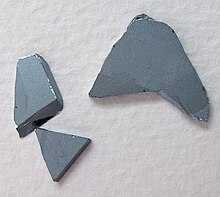Indium arsenide

| |

| |
| Names | |
|---|---|
| IUPAC name
Indium(III) arsenide
| |
| Other names
Indium monoarsenide
| |
| Identifiers | |
3D model (JSmol)
|
|
| ChemSpider | |
| ECHA InfoCard | 100.013.742 |
PubChem CID
|
|
| UNII | |
CompTox Dashboard (EPA)
|
|
| |
| |
| Properties | |
| InAs | |
| Molar mass | 189.740 g/mol |
| Density | 5.67 g/cm3 |
| Melting point | 942 °C (1,728 °F; 1,215 K) |
| Band gap | 0.354 eV (300 K) |
| Electron mobility | 40000 cm2/(V*s) |
| Thermal conductivity | 0.27 W/(cm*K) (300 K) |
Refractive index (nD)
|
3.51 |
| Structure | |
| Zinc Blende | |
a = 6.0583 Å
| |
| Thermochemistry | |
Heat capacity (C)
|
47.8 J·mol−1·K−1 |
Std molar
entropy (S⦵298) |
75.7 J·mol−1·K−1 |
Std enthalpy of
formation (ΔfH⦵298) |
-58.6 kJ·mol−1 |
| Hazards | |
| GHS labelling: | |
  [2] [2]
| |
| Danger[2] | |
| H301, H331[2] | |
| P261, P301+P310, P304+P340, P311, P405, P501[2] | |
| NFPA 704 (fire diamond) | |
| Safety data sheet (SDS) | External SDS |
| Related compounds | |
Other anions
|
Indium nitride Indium phosphide Indium antimonide |
Other cations
|
Gallium arsenide |
Except where otherwise noted, data are given for materials in their standard state (at 25 °C [77 °F], 100 kPa).
| |
Indium arsenide, InAs, or indium monoarsenide, is a narrow-bandgap semiconductor composed of indium and arsenic. It has the appearance of grey cubic crystals with a melting point of 942 °C.[3]
Indium arsenide is similar in properties to gallium arsenide and is a direct bandgap material, with a bandgap of 0.35 eV at room temperature.
Indium arsenide is used for construction of infrared detectors, for the wavelength range of 1–3.8 µm. The detectors are usually photovoltaic photodiodes. Cryogenically cooled detectors have lower noise, but InAs detectors can be used in higher-power applications at room temperature as well. Indium arsenide is also used for making of diode lasers.
InAs is well known for its high electron mobility and narrow energy bandgap. It is widely used as terahertz radiation source as it is a strong photo-Dember emitter.
The optoelectronic properties and phonon vibrations are slightly changed under the effect of temperature over the range form 0 K to 500 K.[4], while the change is quite significant under the effect of pressure, for example InAs converted from a direct band gap semiconductor to an indirect band gap semiconductor.[5]
Ternary and quaternary compounds
Indium arsenide is sometimes used together with indium phosphide. Alloyed with gallium arsenide it forms the ternary semiconductor indium gallium arsenide (InxGa(1-x)As), a material with band gap dependent on In/Ga ratio. Indium arsenide is sometimes alloyed with indium phosphide and Indium antimonide to create a quaternary alloy with a range of band gaps that depend on the different concentration ratios of its components (InP, InAs and InSb), such quaternary alloys was under extensive theoretical studies to study the effect of pressure[6] and temperature[7] on its properties.
Quantum dots can be formed in a monolayer of indium arsenide on indium phosphide or gallium arsenide. The mismatches of lattice constants of the materials create tensions in the surface layer, which in turn leads to formation of the quantum dots.[8] Quantum dots can also be formed in indium gallium arsenide, as indium arsenide dots sitting in the gallium arsenide matrix.
References
- ^ Lide, David R. (1998), Handbook of Chemistry and Physics (87 ed.), Boca Raton, FL: CRC Press, pp. 4–61, ISBN 0-8493-0594-2
- ^ a b c d "Indium Arsenide". American Elements. Retrieved October 12, 2018.
- ^ "Thermal properties of Indium Arsenide (InAs)". Retrieved 2011-11-22.
- ^ Degheidy, Abdel Razik; Elkenany, Elkenany Brens; Madkour, Mohamed Abdel Kader; Abuali, Ahmed. M. (2018-09-01). "Temperature dependence of phonons and related crystal properties in InAs, InP and InSb zinc-blende binary compounds". Computational Condensed Matter. 16: e00308. doi:10.1016/j.cocom.2018.e00308. S2CID 104138117.
- ^ Degheidy, A. R.; Abuali, A. M.; Elkenany, Elkenany B. (2022-06-01). "The Response of Phonon Frequencies, Sound Velocity, Electronic, Optical, and Mechanical Properties of Indium (Phosphide, Arsenide, and Antimonide) to Hydrostatic Pressure". ECS Journal of Solid State Science and Technology. 11 (6): 063016. doi:10.1149/2162-8777/ac79cc. ISSN 2162-8769. S2CID 249836631.
- ^ Degheidy, A. R.; AbuAli, A. M.; Elkenany, Elkenany. B. (2021-05-18). "Phonon frequencies, mechanical and optoelectronic properties for InPxAsySb1-x-y/InAs alloys under the influence of pressure". Applied Physics A. 127 (6): 429. Bibcode:2021ApPhA.127..429D. doi:10.1007/s00339-021-04551-4. S2CID 236387435.
- ^ Degheidy, A. R.; Abuali, A. M.; Elkenany, Elkenany B. (2022-02-26). "Thermal response of electronic, optical, mechanical properties, phonon frequencies, and sound velocity of InPxAsySb1−x−y/InAs quaternary semiconductor system". Optical and Quantum Electronics. 54 (3): 189. doi:10.1007/s11082-022-03566-2. ISSN 1572-817X.
- ^ "oe magazine - eye on technology". Archived from the original on 2006-10-18. Retrieved 2011-11-22.
External links
- Ioffe institute data archive entry
- National Compound Semiconductor Roadmap entry for InAs at ONR web site

